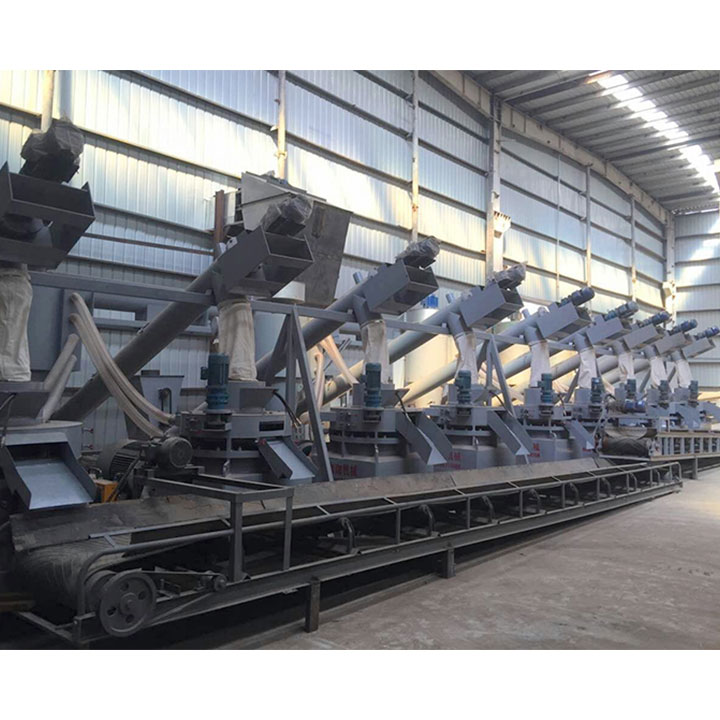Biomass Pellet Machine: Transforming Waste into Renewable Energy
2025-04-29
As the world turns towards more sustainable and eco-friendly solutions, the need for alternative energy sources is greater than ever. One such solution gaining popularity is biomass energy—a renewable and environmentally friendly source of power that helps reduce our dependence on fossil fuels. Central to this revolution is the biomass pellet machine, which plays a crucial role in transforming agricultural, forest, and industrial waste into a highly efficient and usable form of energy: biomass pellets.

In this article, we’ll take a deep dive into what biomass pellet machines are, how they work, and the benefits they bring to both the environment and businesses.
What is a Biomass Pellet Machine?
A biomass pellet machine, also known as a biomass pellet mill, is a mechanical device designed to compress and mold biomass materials—such as wood chips, sawdust, straw, and agricultural residues—into compact pellets. These pellets serve as a sustainable and efficient source of energy for various applications, from heating and power generation to industrial processes.
By compressing biomass materials under high pressure, the pellet machine creates small, uniform pellets that are easy to transport, store, and burn. The result is a highly efficient fuel source with a high energy density and minimal emissions.
How Does a Biomass Pellet Machine Work?
The basic process of turning raw biomass into pellets involves several key stages:
1. Raw Material Preparation
Before pellets can be made, the biomass material needs to be properly prepared. This often involves grinding or milling the raw materials into smaller particles. The size and consistency of the raw material are essential for efficient pelletizing. The smaller the material, the easier it is to compress into pellets.
2. Pelletizing Process
Once the raw material is prepared, it is fed into the pellet machine, where it is subjected to high pressure through a die and a roller system. The pressure causes the materials to bond together and form solid pellets. During this process, the machine uses heat generated from friction to soften the lignin (a natural binder in plant fibers) in the biomass, which helps hold the pellets together.
3. Cooling and Packaging
After the pellets are formed, they are usually hot and soft. They need to be cooled down to harden and achieve the right density. Cooling is typically done by air or water. Once the pellets are cooled, they are ready for packaging and distribution.
Benefits of Biomass Pellet Machines
1. Renewable Energy Source
One of the most significant advantages of biomass pellets is that they provide a renewable source of energy. Biomass is derived from organic materials that are replenished annually, unlike fossil fuels, which take millions of years to form. By converting waste into pellets, biomass pellet machines contribute to the sustainable use of natural resources.
2. Waste Reduction
Agricultural, forest, and industrial residues are often considered waste materials that can be challenging to dispose of. Biomass pellet machines provide an efficient and eco-friendly way to convert this waste into a valuable energy resource. This not only reduces landfill waste but also minimizes environmental pollution caused by improper waste disposal.
3. Cost-Effective Fuel
Biomass pellets are generally more affordable than traditional fossil fuels like coal, oil, and gas. They are also more energy-efficient, providing high combustion efficiency and lower heating costs. As the demand for renewable energy increases, biomass pellets are expected to become even more affordable and widely available.
4. Low Carbon Emissions
Biomass pellets are a cleaner energy source compared to traditional fossil fuels. When burned, they release carbon dioxide (CO2), but the CO2 emitted is part of the natural carbon cycle, as the biomass originally absorbed this CO2 from the atmosphere during its growth. This makes biomass energy a carbon-neutral solution, unlike fossil fuels, which release CO2 that has been trapped underground for millions of years.
5. Versatile Applications
Biomass pellets can be used for a variety of purposes, including:
- Home Heating: Pellets can be used in specialized stoves or boilers to heat homes and buildings. This provides an eco-friendly alternative to heating with oil or gas.
- Power Generation: Many power plants are now converting to biomass to generate electricity. Biomass pellets can be burned in boilers to produce steam, which drives turbines to generate power.
- Industrial Use: Some industries use biomass pellets as a heat source in manufacturing processes, especially in areas such as food processing, cement production, and paper milling.
6. Job Creation and Economic Benefits
The biomass pellet industry also has the potential to create jobs, especially in rural areas. As demand for biomass increases, so does the need for raw materials, processing plants, and distribution networks. This leads to job creation in agriculture, manufacturing, and logistics.
Key Features of Biomass Pellet Machines
When choosing a biomass pellet machine, there are several features to consider:
1. Pellet Size and Density
Pellet size and density are critical factors that influence the efficiency of burning the pellets. Most pellet machines can produce pellets in various sizes to meet the requirements of different applications, whether it’s for heating stoves, industrial boilers, or power generation.
2. Energy Efficiency
A good biomass pellet machine should operate efficiently with minimal energy consumption. Look for machines that have a high pellet output with low power requirements. Energy efficiency can significantly reduce operational costs over time.
3. Durability
Since biomass pellet machines operate under high pressure and temperature, durability is a critical consideration. Machines made from high-quality steel and designed to withstand wear and tear will last longer and require less maintenance.
4. Ease of Use and Maintenance
A well-designed biomass pellet machine should be easy to operate and maintain. Look for models that come with user-friendly controls and require minimal downtime for maintenance. Regular maintenance will ensure the machine operates efficiently and continues to produce high-quality pellets.
Applications of Biomass Pellet Machines
1. Home Heating Solutions
Many households and small businesses use biomass pellets to heat their homes and facilities. Pellet stoves and pellet boilers are designed to burn biomass pellets in an efficient manner, offering a clean and reliable heating solution that reduces reliance on oil and gas.
2. Industrial Power Plants
Power plants are increasingly switching to biomass as an alternative fuel source to reduce their carbon footprint. Biomass pellet machines provide a way to produce high-quality pellets that can be used to generate electricity in large-scale power plants.
3. Farming and Agriculture
Farmers can benefit from biomass pellet machines by converting agricultural residues such as straw, rice husks, and corn stalks into fuel pellets. These pellets can then be used to power equipment or sold as a renewable energy source, generating additional income.
4. Waste-to-Energy Plants
Biomass pellet machines are also used in waste-to-energy plants, where organic waste from food processing, wood processing, and other industries can be converted into usable energy. This not only reduces waste but also provides an alternative to landfill disposal.
Conclusion
Biomass pellet machines are playing a pivotal role in the global shift toward renewable energy. By converting waste into valuable fuel pellets, these machines not only contribute to reducing carbon emissions but also offer an affordable, efficient, and sustainable energy solution. Whether you're looking to generate heat for your home or power a large industrial facility, biomass pellets are an eco-friendly and cost-effective choice.
With the growing demand for renewable energy sources, the future of biomass pellet machines looks promising. By harnessing the power of organic waste, we can build a cleaner, greener world for generations to come.


